Red Sea Project
The Red Sea Project is a massive tourism project and an ideal destination for sustainable tourism and urban development. It was created around the most beautiful natural treasure in the world, the Red Sea. It was announced in 2017, but actual development and implementation began in 2019 by the Red Sea Global Company, with full support from the Public Investment Fund.
The Red Sea Project is designed over a massive area of 28,000 square kilometers of land and pure waters, including many facilities, services, and landmarks such as an impressive collection of over 90 islands.
The project includes numerous ancient cultural and heritage sites, 5-star luxury hotels, and high-quality residential units. Additionally, it features entertainment and essential services that create an integrated and attractive environment, offering an exceptional experience for citizens and attracting tourists from all over the world.
Also read: The most important hotel projects in Saudi Arabia
The Red Sea Project highlights the aesthetic and cultural power of Saudi Arabia, opening new horizons in the economic and cultural fields and encouraging social interaction. Through this article, we will shed light on the most prominent information and details related to the Red Sea Project and its goals, which align with the ambitious Vision 2030.
Red Sea Project Location
The Red Sea Global Company has shown exceptional skill in choosing the best locations for the Red Sea Project, situated at the heart of the world. It stands out with its strategic and vibrant positioning along the Arabian coastline of Saudi Arabia, renowned for its stunning landscapes. The project spans an enormous area of 34,000 square kilometers and stretches from the city of Al-Wajh in the north to the city of Umluj in the south, located about 500 kilometers north of Jeddah.
There is a strong connection between the Red Sea Project and Vision 2030, announced by Crown Prince Mohammed bin Salman. This is reflected in the project’s emphasis on sustainability in construction, incorporating renewable energy, water conservation, and environmental preservation, which align with the ambitious Vision 2030 of Saudi Arabia.
Red Sea Project Goals
The Red Sea Project and Vision 2030 are both aimed at localizing the tourism sector in Saudi Arabia by establishing international resorts that attract tourists both locally and globally. The following points highlight the key objectives of the Red Sea Project, including how it contributes to the ambitious Vision 2030:
- Stimulating the kingdom’s economy: Creating a global tourism destination with new standards for sustainable development and economic advancement for Saudi Arabia, while attracting private investments both locally and internationally, as well as supporting small and medium-sized businesses to increase sales and investments.
- Providing job opportunities: The Red Sea Project aims to create thousands of job opportunities for Saudi youth, potentially up to 70,000 jobs. This includes building a city for employees, which will have state-of-the-art administrative offices and upscale residential areas, along with services and commercial facilities for both citizens and tourists, ensuring a developed and integrated environment.
- Environmental protection and sustainability: Protecting and developing the nation’s natural treasures, preserving its cultural heritage, and reducing pollution in all its forms. This is achieved through sustainable construction projects, reliance on renewable energy, and maintaining environmental balance through green infrastructure, making it a major goal of the Red Sea Project and Vision 2030.
- Promoting tourism and attracting foreign direct investment: The Red Sea Project aims to offer an exceptional experience in a natural environment with stunning beauty to attract tourists worldwide. This is accomplished by implementing and developing luxurious resorts and hotels with elegant designs inspired by global European styles that cater to all tastes.
The project also aims to build an international airport to serve the various destinations within the Red Sea Project.
Key stakeholders in the Red Sea Project
The Red Sea Global Company (ASG) is the entity responsible for the development of the Red Sea Project. It was established in 2018 specifically for the development of the project, with Crown Prince Mohammed bin Salman, the visionary behind Vision 2030, as its chairman. The company is fully owned by the Public Investment Fund.
The company was registered with the Ministry of Commerce as a closed joint-stock company to grant it the freedom to operate in the geographical area of the project, with the goal of creating new standards for sustainable development and following a dedicated approach to preserve the ecosystem, such as minimizing waste disposal, reducing carbon dioxide emissions, and relying entirely on environmentally friendly renewable energy.
The Red Sea Global Company adheres to clear standards and visions in executing its projects, with an emphasis on using the latest technologies and high-quality materials throughout all construction stages, blending luxury, elegance, sustainability, and innovation in redefining development concepts.
The company’s portfolio extends beyond the Red Sea Project and includes three globally leading projects along the western coast of Saudi Arabia.
Development phases of the Red Sea Project
According to the approved master plan for the Red Sea Project’s development by 2030, the project will be developed in two main phases:
First Phase:
- Launched in 2019
- More than 800 contracts signed, worth over 20 million SAR
- Includes 16 large hotels with 3,000 rooms built on islands
- Two resorts in the mountainous and desert regions accommodating 300,000 visitors
- This phase also includes the development of many commercial, entertainment, and infrastructure facilities, an airport for the destination, and a yacht marina
Second Phase:
- Launched in 2023 and expected to be completed by 2030
- Includes 8,000 hotel rooms distributed across 22 islands, 50 hotels, and 6 resorts in the mountainous and desert regions
- Residential properties include 1,000 units across 22 islands
- Features a marina for yachts, golf courses, and entertainment
- Over 15,000 workers involved in the project
Timeline of the Red Sea Project Phases
The international company developing the project laid out a timeline for the Red Sea Project, specifying the milestones from its inception to its completion, as follows:
- 2018 / 1439 AH: The establishment of an independent company for the Red Sea Project, named the Red Sea Development Company.
- 2019 / 1440 AH: Launch of the first phase of the project, which included building key facilities such as the Red Sea Airport, initial infrastructure, luxury hotels, and the port.
- 2021 / 1442 AH: The British company WATG and Partners unveiled the design for the project’s main island, Coral Bloom.
- 2021 / 1443 AH: The final design of Desert Rock Village, a mountain resort located in one of the Red Sea Project’s valleys, was revealed.
- 2022 / 1443 AH: WSP began the next phase of the multi-modal operational readiness plan for the Red Sea and prepared to welcome the first tourists by early 2023.
- 2022 / 1444 AH: The Red Sea Company expanded to become the Red Sea Global, especially after integrating the Amala project. Following this expansion, the company announced the construction of the (Faena The Red Sea) resort, located along the Red Sea coast, in partnership with a hospitality brand specializing in luxury hotels.
- 2023 / 1444 AH: The second phase was launched, marked by the company’s introduction of the Akun project for adventure sports.
Key projects Under the Red Sea development companies
The first phase of the Red Sea Project involves several significant projects, with an estimated cost of approximately SAR 30 billion. Below are the main highlights:
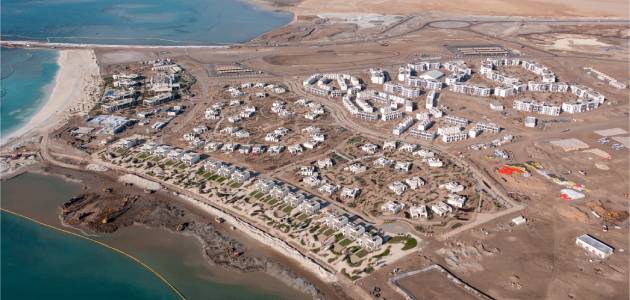
Global residential village
This innovative and creative housing project is designed with modern styles and high-quality finishes. It offers a range of residential units with diverse sizes and layouts to cater to various customer and investor needs, both financially and family-wise.
Employee city
The Employee city is a key project spanning approximately 1.5 million square meters. It is a fully integrated city designed to accommodate over 10,000 employees. It includes essential and recreational facilities, such as advanced medical centers, sports, and social clubs, parks, a kids’ area, and administrative offices.
The city also boasts a hotel with 144 rooms, ensuring that employees can select accommodations suited to their needs.
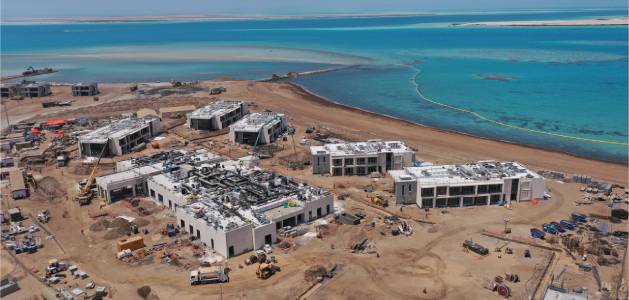
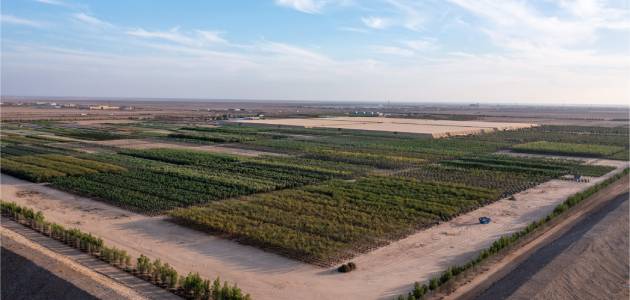
Agricultural nursery
The agricultural nursery, now fully operational, spans around 1 million square meters. It is designed to cultivate over 15 million seedlings of various plant species.
Road network
The establishment of a comprehensive road network facilitates access to different project areas, with a total length of approximately 80 kilometers.
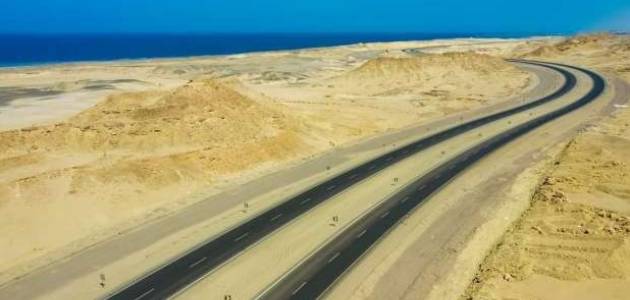
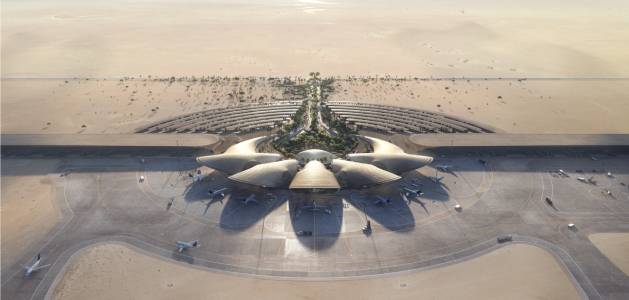
Red Sea Project airport
This international airport features sustainable and unique architectural designs inspired by the area’s stunning natural beauty. It enables over 80% of the global population to reach the project within a few hours.
The airport’s design integrates seamlessly with the surrounding natural beauty and includes advanced facilities like an enclosed garden, a control tower, three helicopter pads, a seaplane landing strip, and a 3,700-meter-long runway. The airport is expected to handle approximately one million visitors annually.
Red Sea Project Islands
The project incorporates several islands, each with distinct natural features. A total of 22 islands are being developed, with notable examples including:
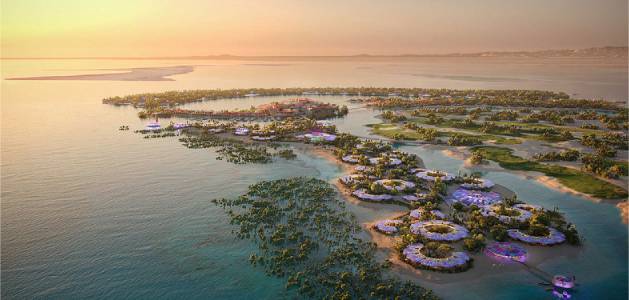
Shurayrah Island
This serves as the core of the Coral Bloom concept. It spans 5.6 square kilometers and includes 11 hotels, multiple dolphin-shaped beaches, and 18 resorts with golf courses.
Sheybarah Island
Known for its futuristic design, featuring floating circular villas resembling a string of pearls. It includes 73 accommodations with beachfront and overwater villas.
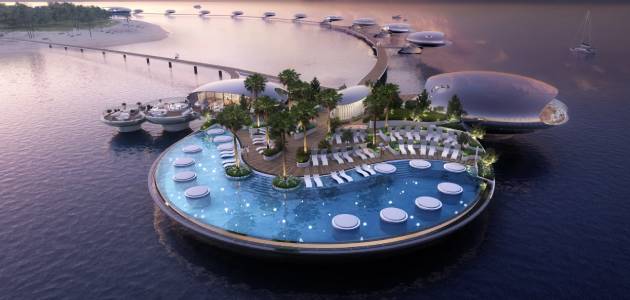
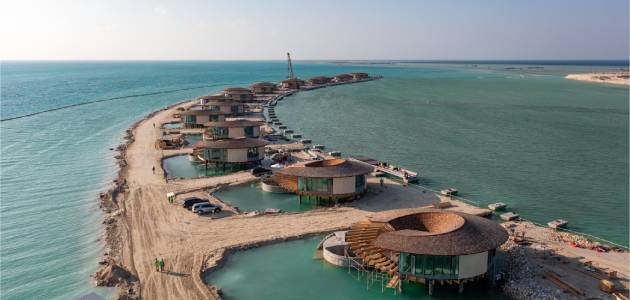
Ummahat Al Sheikh Island
Located on the western coast of Tabuk, this island features coral reefs, clear waters, and white sandy beaches. Designed by British architecture firm Foster + Partners, the island includes an H12 hotel and 92 structures with 31 overwater villas.
Red Sea Project cost
The total cost of the Red Sea Project is estimated at $500 million. As of now, around 70% of the contracts for the project have been awarded to Saudi companies, with over 500 contracts worth $12 billion signed with various international firms.
Challenges faced by the Red Sea Project
Despite the company’s meticulous approach, several challenges remain:
- High costs: The total cost of the project is estimated at SAR 50 billion.
- Marine environment: Careful measures are needed to preserve the Red Sea’s natural ecosystem.
- Human resources: Recruiting and training a large workforce to execute the project is essential.
- Competition: The project faces significant competition from other global developments.
Scavo: A Project Monitoring Platform
Scavo is a powerful digital platform for professionals and companies in the construction and real estate sectors. It offers real-time project tracking, market analytics, and innovative solutions for efficient planning and execution.
By subscribing to Scavo, users gain access to exclusive project timelines, contractor databases, and detailed progress reports for major projects, including those aligned with Saudi Arabia’s Vision 2030.
Scavo is tracking these major projects and many more, if you would like to find out more on how you can subscribe to receive access to project data, please contact us.

